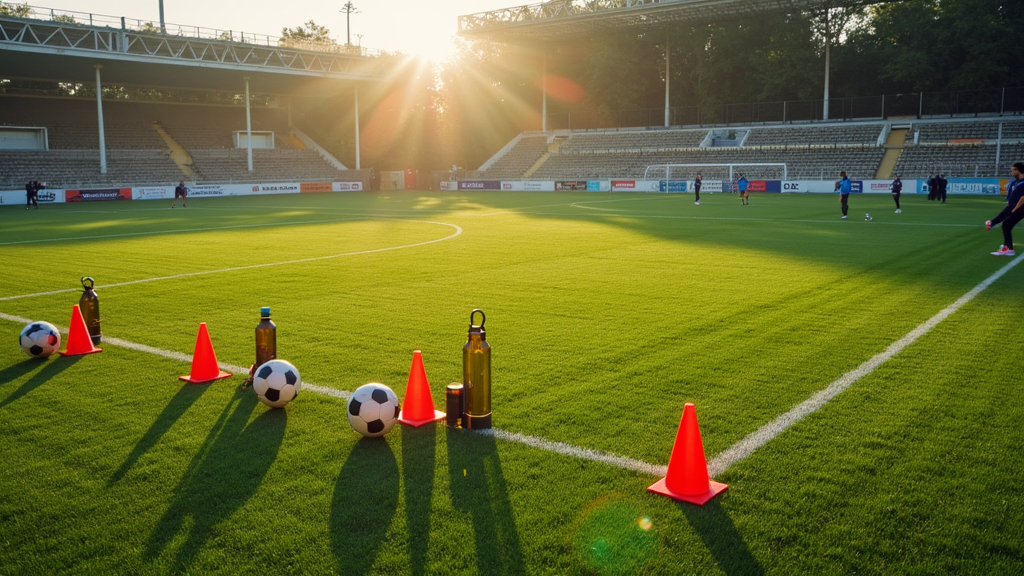
If you ever feel like you start strong but run out of gas before the final whistle in a soccer match, you’re not alone. Even the most talented players find that stamina, both physical and mental, makes or breaks their game days. Building real stamina for soccer isn’t about running laps endlessly. It’s about smart training, good habits, and a bit of patience.
Maybe you get winded after a few sprints, or you notice your legs burning in the last 15 minutes. It’s frustrating, but the good news is that stamina is something you can improve with the right approach. A proven training plan, the right fuel, and consistency can help you go the extra mile on match day. Plus, improving your stamina doesn’t just help you physically; it also makes you mentally tougher when the game gets intense.
Below is a step-by-step guide to ramping up your stamina for soccer so you can play harder, recover quicker, and actually enjoy those last few minutes on the field. Ready to level up your game? Let’s check out each step in detail! www.wealthyaffiliate.com?a_aid=a12e49d9
Step 1: Figure Out Your Starting Point
Before making changes to your routine, it’s helpful to know where you stand. Soccer stamina covers endurance, speed recovery, and mental toughness. A simple way to check your current level: time how long you can run at a steady pace before needing to stop, or play a smallsided game and note when you start to lag.
Questions to Consider:
- How long can I run without losing intensity?
- Do I recover quickly between sprints during a game?
- Am I totally spent after each half?
- Is it my legs, breathing, or focus that goes first?
The answers help you target the right parts of your training. By being honest about your stamina weaknesses, you can set realistic goals and see measurable progress as you put in the work.
Step 2: Build a Cardio Foundation
Cardio endurance is a huge piece of the soccer stamina puzzle. It lets you keep moving for the whole match instead of feeling slow and tired before halftime. For soccer, you want a mix of steady runs and intervals to build allaround fitness.
How to Train Your Cardio for Soccer:
- Steadystate runs: Run at a comfortable pace for 20 to 40 minutes, 1 to 2 times per week. This boosts your overall endurance and helps you develop a strong fitness base that supports other types of training.
- Interval sprints: Do sprints of 30 seconds, then jog or walk for 1 minute. Repeat 8 to 10 times. This is super useful for mimicking the stopandstart of a real game where you need to recover quickly and go again.
- Smallsided games: Play 3 vs. 3 or 5 vs. 5. The high pace and fewer breaks really challenge your stamina, demanding that you push through fatigue and stay sharp with the ball.
Mixing these up during the week helps prevent boredom and avoids overtraining. Plus, variety in your cardio keeps your sessions interesting and prepares your body for the unpredictable pace of matches.
Step 3: Add Strength and Power Sessions
Stronger muscles mean better stamina because your body can handle more work before getting tired. Focus on exercises that build leg, core, and fullbody strength to really make a difference in your performance.
Effective Strength Drills:
- Squats and lunges: Great for soccer legs and preventing fatigue after repeated sprints. These moves also lower your risk of injury by stabilizing your joints.
- Planks and core work: A strong core keeps your form solid late in the game, which is crucial for balance and ball control.
- Plyometrics: Box jumps or jump squats add explosive strength you need for bursts of speed, powerful kicks, and quick changes in direction.
Try to add two strength workouts each week to your routine. No need for heavy weights if you don’t want them; even bodyweight can do the job. Focus on good form and gradually increase your reps or resistance as you get stronger.
Step 4: Train with Game-Like Intensity
The best stamina comes from pushing yourself in training like you would in a real match. Include highintensity drills that ramp up your heart rate and mirror the chaos of a game environment. Practicing at game speed also helps prepare your mind for pressure situations during real matches.
Favorite Stamina Building Drills:
- Shuttle runs: Set up cones 20 meters apart and run back and forth as fast as you can for a set time or reps. This drill teaches you to accelerate, decelerate, and push through tired legs.
- Circuit training: Combine quick footwork, sprints, and even some ball work for nonstop action. Circuits give you a great mix of cardio and strength in one session.
- Possession games: Set up small groups and compete to keep the ball under pressure, adding running and decisionmaking together. These games sharpen your mental stamina and force you to work hard off the ball.
Push yourself in these sessions, but always listen to your body to avoid burnout or injury. Remember, quality matters more than quantity in highintensity soccer training.
Step 5: Make Recovery a Priority
Stamina doesn’t just come from running hard; it also depends on how well you recover. Your muscles need time to fix and get stronger between sessions. Planning your rest is just as important as planning your workouts.
Ways to Recover Faster:
- Get enough sleep; at least 7 to 9 hours per night is really important for athletes. Good sleep helps your muscles rebuild and leaves you feeling refreshed for your next session.
- Add light stretching or yoga on rest days to keep muscles loose and reduce the risk of injury.
- Use foam rollers or massage tools to help reduce soreness and aid muscle recovery after tough matches or workouts.
Tired muscles don’t just feel heavy. They don’t build stamina as effectively either, which is why recovery days are nonnegotiable if you want long term progress.
Step 6: Don’t Forget Nutrition and Hydration
You can’t outrun a bad diet. The right fuel keeps your energy up and helps your body recover, especially when you play backtoback games or tournaments.
Simple Nutrition Tips for Soccer:
- Focus on whole foods: lean proteins, complex carbs like rice, oats, or sweet potatoes, lots of veggies, and healthy fats. These foods provide the long lasting energy you need to perform your best.
- Stay hydrated before, during, and after training. Dehydration drains your energy super fast. Carry a water bottle with you and sip regularly throughout the day.
- Eat a balanced snack with carbs and protein after training to help your body recover. Examples include Greek yogurt with fruit, a turkey sandwich, or a smoothie with milk and bananas.
Experiment a bit to find what foods and drinks work best for you. Everyone’s different, but skipping meals or just eating junk food usually backfires. A little planning goes a long way toward helping you play stronger and longer.
Step 7: Stay Consistent and Track Progress
Improving your stamina doesn’t happen overnight. A few weeks of regular, focused training go a long way, but you need to stick with it to really see benefits. I like to keep notes on my phone or in a notebook to see how I’m doing every few weeks. Seeing your improvements on paper can give a surprising boost in motivation and help you tweak your routine as needed.
Tracking Tips:
- Write down your running times, workout reps, or even how you felt in the second half of a game. Noticing patterns makes it easier to identify what works well for your body.
- Celebrate little wins. Maybe you ran farther, didn’t tire out as quickly, or recovered speed after a sprint. These small victories add up over time and show your stamina is improving.
- If you plateau or feel stuck, shake up your routine; change running distances, tweak drills, or add new exercises and drills to keep things fresh.
The more consistent your training and habits, the better stamina you’ll build for soccer matches. Over time, you’ll handle tougher games, come back quicker from hard runs, and keep your focus even when things get hectic on the field.
Common Questions & Troubleshooting
What if I’m short on time to train?
Even 20 to 30 minutes of focused, high effort intervals or smallsided game drills are better than nothing. Quality over quantity is key when the clock is ticking and you want results fast.
I keep getting tired in the last 10 minutes. What should I do?
- Doublecheck your nutrition and hydration before the game. Sometimes, low energy is just poor fueling.
- Add more interval training to your weekly routine to get your body used to repeated bursts of effort.
- Make sure you’re recovering well. Overtraining can zap your energy fast, so listen to signals like soreness or constant fatigue.
How do I avoid burning out or getting injured?
Listen to your body. Overdoing it, especially with extra running or tough backtoback sessions, leads to sore, tired muscles. Balance hard sessions with easier recovery days. Learning to rest is as important as learning to work hard—it’s what lets your body build better stamina over time.
Action Plan and Next Steps
Consistent, soccerfocused training builds stamina that pays off every single match. The best part is, you can tweak your routine to fit your current level and busy schedule so you keep improving without feeling overwhelmed. Remember, stamina is built by making small, steady changes rather than drastic overhauls.
Your Stamina Boosting Plan:
- Pick one cardio or strength session to add this week. Just getting started can ignite momentum for more improvements down the line.
- Fuel up with quality food and stay hydrated during the day so your body always has what it needs to perform and recover.
- Track your progress every week so you can see real changes. Nothing feels better than seeing your hard work pay off during game time.
What stamina boosting tip are you excited to try for your next soccer match? Share your favorite drills or snack ideas below! If you stick with these habits, you’ll soon see stronger finishes, faster recovery, and more confidence every time you step onto the field.
